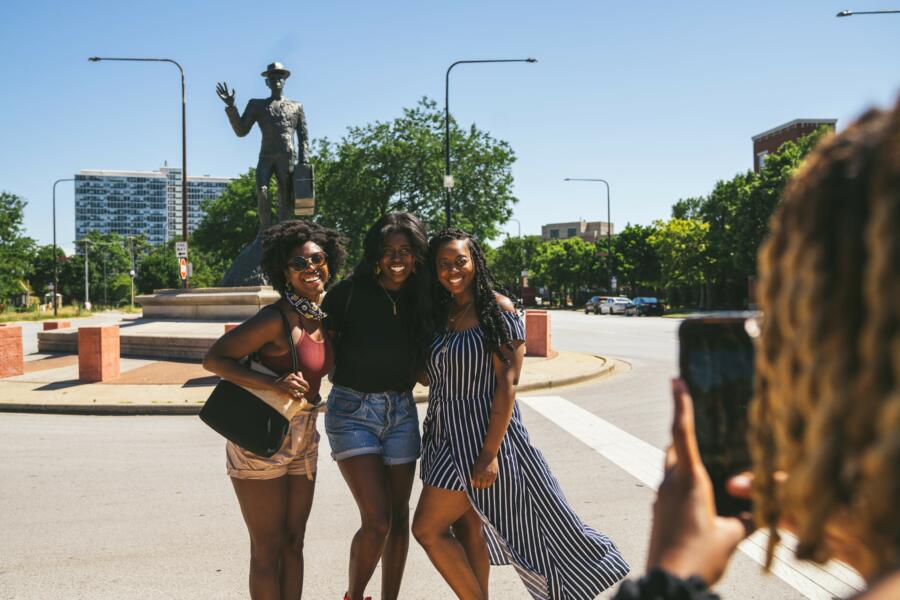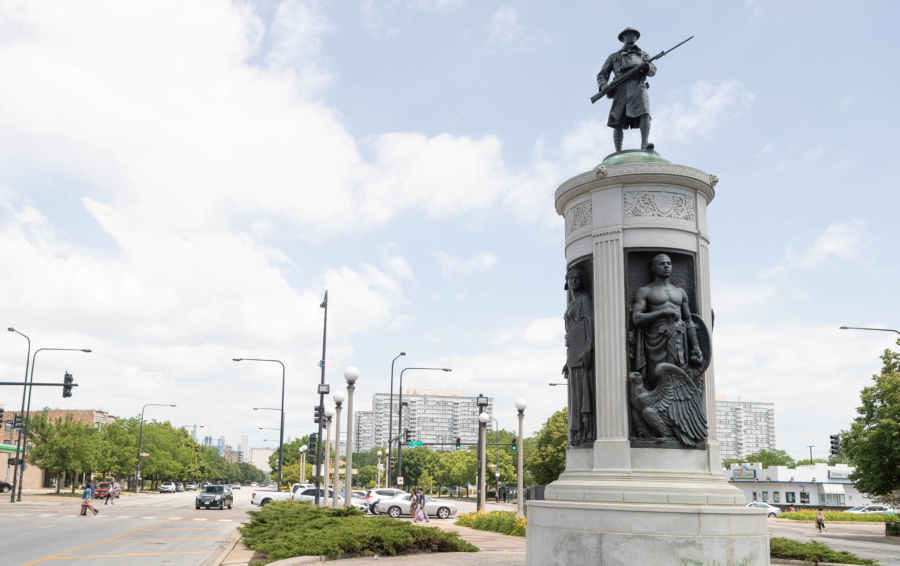For as long as Chicago has been Chicago, Black people have been shaping the city’s culture and leaving a lasting impact. After all, Chicago’s first permanent non-Indigenous settler, Jean Baptiste Point du Sable was a Black man from Haiti (who now has a museum and bridge named in his honor).
The city’s historically Black neighborhoods (like Bronzeville, Pullman, Chatham, Jackson Park Highlands, Kenwood, and Oakland to name a few) grew to become enclaves for Black Americans flocking to Chicago after the Civil War in search of jobs, resources, and a different way of life.
Since then, Black Chicagoans have been instrumental in shaping many of the city’s, and the nation’s, most important historical moments. Here are just a few ways to experience Black history and heritage around Chicago.
Bronzeville: Chicago’s Black Metropolis

In Bronzeville, you can find dozens of examples of Black history dating as far back as the 1800s. Once known as the city’s “Black Metropolis,” Bronzeville has maintained its rich legacy as a central hub for commerce and community. It’s also home to a wealth of landmarks that honor the neighborhood’s history.
In the heart of Bronzeville, The Eighth Regiment Armory was the first U.S. armory built for an African American military regiment. You can pay tribute to those brave soldiers by visiting The Victory Monument, erected to memorialize the “fighting 8th.”
As time went on, Bronzeville continued to foster a bustling arts and culture scene. The Forum, now listed on the National Register of Historic Places, once hosted music greats from Nat ‘King’ Cole to The Jackson 5, along with political speeches, union meetings, and civil rights events.
One of the city’s earliest jazz clubs, the Sunset Cafe once welcomed famous artists of the day, including Louis Armstrong. Though the club is closed, the landmark building still stands at 315 E 35th St. Step inside to see some of the club’s original murals.
Nearby, The Supreme Life Building, the first African-American-owned and operated insurance company in North America, is another Bronzeville structure on the National Register of Historic Places.
Another local landmark is the Chicago Defender building, which once housed the nation’s oldest and most outspoken Black-run newspaper, still in operation today.
Black history museums in Chicago

In Chicago, we’re lucky to have access to quite a few museums with well-curated collections dedicated to preserving and sharing Black history, art, culture, and more.
In Washington Park, The DuSable Black History Museum has been in operation for over 60 years and boasts more than 15,000 photos, artworks, and artifacts. The renowned space is the country’s first independent museum dedicated to the history of African and African American culture.
A great way to educate and entertain younger audiences, the Bronzeville Children’s Museum is the only children’s museum in the world dedicated to African American history.
Travel a little further south and you’ll reach Chicago’s first unit of the National Park Service: Pullman National Historical Park. In addition to viewing original architecture from the nation’s first planned industrial town, visitors can check out the A. Phillip Randolph Pullman Porter Museum to learn more about Pullman’s primarily Black workforce and their families who lived and worked in the district.
Explore more: Immerse yourself in Black art and culture in Chicago.
Black historic sites in Chicago

Bronzeville isn’t the only place in Chicago where Black history comes to life. Throughout the city, you can find monuments to the achievements and advancements of Black Chicagoans.
In the South Loop, Quinn Chapel is home to Chicago’s oldest African-American congregation and was once an integral stop for slaves passing through Illinois on the Underground Railroad.
The Johnson Publishing Company Building was the first Black-owned building in downtown Chicago and the headquarters for historic publications like Jet and Ebony magazines.
A bit further down Michigan Avenue, you’ll find the legendary Chess Records Office and Studio. Once considered “America’s greatest blues label” Chess Records produced notable acts including Muddy Waters, Howlin’ Wolf, Little Walter, Etta James, and more. Tours are available by reservation.
Near the United Center, you’ll find theWest Town State Bank Building where pioneering radio broadcasters Jack L. Cooper and AI Benson worked to bring Black music and news to the city’s airwaves in the ‘30s and ‘40s.
In Marquette Park, visit the Martin Luther King Jr. Living Memorial. The public sculpture commemorates a protest Dr. King organized in 1966 when the area was designated “whites-only.”
For some not-so-distant history, you can even visit the spot in Hyde Park where Barack and Michelle shared their first kiss, appropriately named the Obama Kissing Rock.
Historic homes of Black Chicagoans
Throughout the city, you can see the homes of some of the most well-known Black Chicagoans, including Nat King Cole, Louis Armstrong, and Ida B. Wells-Barnett. But if you dig a little deeper, you’ll discover a few former homes of Black historical figures with lesser known stories, but just as much history to share.
The John and Mary Jones House is located in what is now Printers Row. John Jones and Mary Jane Richardson Jones became central figures of the abolitionist movement in Chicago and used their home as a political gathering place and station on the Underground Railroad.
The Rosenwald Apartmentsin Bronzeville is a courtyard-style housing development once home to everyone from Gwendolyn Brooks to Duke Ellington to boxer Joe Louis to Grammy-winning producer Quincy Jones.
A little further away sits the Griffiths-Boroughs House, one of the few remaining historic mansions in Bronzeville and the birthplace of the DuSable Black History Museum
Acclaimed author Richard Wright (Black Boy, Native Son) and playwright Lorraine Hansberry (A Raisin in the Sun) also put down roots in Chicago and their homes still be seen today.
Black history tours of Chicago

ChicagoMahogany Tours are led by Sherman “Dilla” Thomas, urban historian, TikTok star, and a recent Chicago Tourism Ambassador of the Year. Choose from tours of Bronzeville, Pullman, Englewood, Chatham, and more, spotlighting the neighborhoods’ people, architecture, and impact.
Gone Again Travel & Tours offers the Chi-Town Soul Trolley, Black Restaurant, and History Tour, a great option for groups looking to explore all over the city.
You can get a free one-on-one experience with a knowledgeable Chicago native when you book a Chicago Greeter visit. These walks are led by welcoming volunteer Greeters who share interesting facts, insider tips, and an authentic perspective on life in Chicago’s various neighborhoods.

